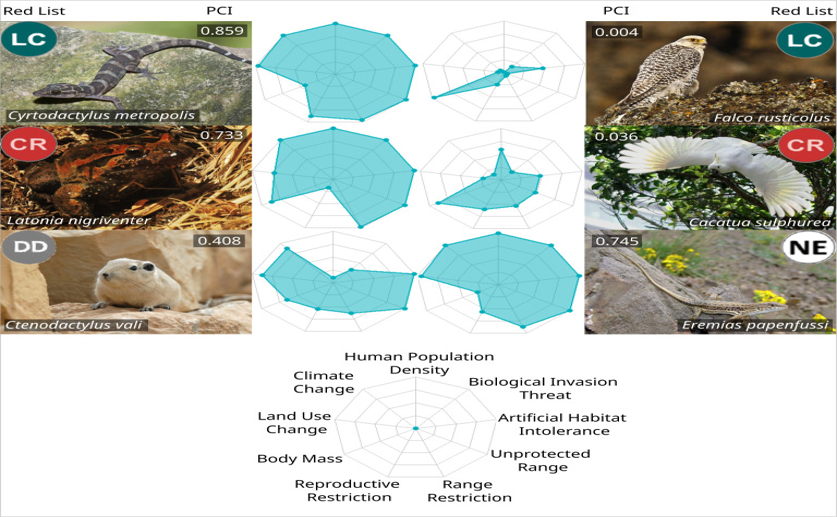Greg Howard
26th October, 2025

Distribution of variables used in the calculation of Proactive Conservation Index (PCI) for six species of land vertebrates.
Key Findings
- A new tool, the Proactive Conservation Index (PCI), was developed to predict future biodiversity threats globally, complementing existing methods like the IUCN Red List
- The PCI considers both projected future threats and species traits, revealing that many currently ‘Least Concern’ or ‘Near Threatened’ species may require more urgent conservation attention
- Reptiles are identified as the group of land vertebrates with the highest future conservation priority, despite amphibians currently having the highest proportion of threatened species
The PCI integrates two key factors: projected future threats and species traits that make them vulnerable to these threats. Unlike the IUCN Red List, which largely relies on historical data and current population sizes, the PCI looks ahead, considering how factors like climate change and habitat loss are likely to impact species in the coming decades. This forward-looking approach is crucial because species can be declining for a significant period before being officially classified as threatened[2]. The index then combines this with species characteristics – for example, a species with a limited geographic range or specialized diet would be considered more vulnerable than a widespread generalist.
The study involved assessing the conservation priority of over 33,500 land vertebrate species worldwide. The researchers then compared these PCI scores to existing IUCN Red List classifications to see how well the two approaches aligned. The results showed a general agreement between the PCI and the IUCN Red List, but with substantial variation within each threat category. This means that many species currently classified as ‘Least Concern’ or ‘Near Threatened’ may actually require more urgent conservation attention than previously thought.
Interestingly, the PCI highlighted reptiles as the group of land vertebrates with the highest future conservation priority, despite amphibians currently having the highest proportion of threatened species according to the IUCN Red List[2]. This suggests that reptiles may be particularly vulnerable to future environmental changes, a finding that warrants further investigation. Furthermore, the study revealed that species in the ‘Near Threatened’ category are likely to face conservation challenges comparable to those already classified as ‘Threatened’, emphasizing the need to proactively address the needs of these species before their status deteriorates further.
Geographically, the PCI identified arid ecoregions, tropical montane forests, and islands as areas where current conservation priorities, as defined by the IUCN Red List, may not adequately reflect future threats. These regions harbor unique and sensitive fauna that will likely experience high levels of environmental stress in the coming years. Crucially, the PCI also found no correlation between the proportion of threatened species according to the IUCN Red List and existing protected area coverage. This suggests that many areas with high conservation needs are currently under-protected, highlighting a critical gap in global conservation efforts.
The researchers also observed that the PCI effectively identified currently unprotected ecoregions with vulnerable species that are projected to experience significant threats in the future. This is a key advantage over traditional approaches, which tend to focus on areas already recognized as biodiversity hotspots. The findings of[2] show that a widespread global erosion of species is occurring, with almost half of species undergoing declines, and this study builds on this by identifying where these declines are most likely to occur in the future.
To facilitate the practical application of the PCI, the team developed a user-friendly web application and an R package, allowing conservation practitioners to calculate PCI scores for specific taxa and regions, and to customize the index based on local threats and species attributes. This flexibility is essential, as the severity of different threats and the importance of species traits can vary considerably across different ecosystems. The work of[3] highlights the importance of population trend indicators in biodiversity monitoring, and the PCI offers a powerful new tool for tracking and responding to these trends.
The development of the PCI represents a significant step forward in proactive conservation planning. By integrating future threats and species vulnerability, this index provides a more nuanced and comprehensive assessment of extinction risk, enabling conservation efforts to be targeted more effectively and efficiently. While economic growth continues to contribute to biodiversity loss[4], tools like the PCI are essential for prioritizing conservation actions and mitigating the impacts of human activities on the planet’s biodiversity.
References
Main Study
1) The future-focused Proactive Conservation Index highlights unrecognized global priorities for vertebrate conservation
Published 21st October, 2025
https://doi.org/10.1371/journal.pbio.3003422
Related Studies
Related Articles

